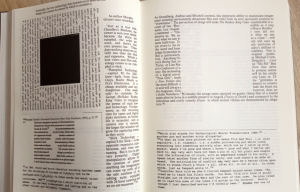60 Exploring the Structure of a Text
Exploring a text’s structure may sound a little complicated, but it really isn’t. We’re simply looking for how it’s been constructed or built, and then we’re thinking about how the structure supports the work the text is trying to do. The fancy literary terms for this are “form” and “function.” Form refers to the way the text is structured, while function refers to what it communicates to the reader.
Consider these questions when thinking about structure:
- How is the text organized? (Does it seem logical? Is it in time-related, chronological order? Does it skip around in time with flashbacks or flash-forwards?)
- Is it divided into obvious sections? Do the sections have headings, or are they just visually separated?
- Does the author use comparison/contrast, explore cause and effect, or examine a process to present their ideas?
- Is there a lot of detail and description in the text?
Does the author use dialog? - Does the author do anything unusual* or unexpected with the text?
*Speaking of unusual texts, sometimes the author will do something unexpected with the text’s form in order to support its function. As an example, check out these examples from Mark Z. Danielewski’s House of Leaves, a novel that includes some extraordinary structures.

In the example shown to the right here, you can see some of the unusual ways Danielewski has arranged text on two of the pages. His book contains all sorts of different textual anomalies (something that deviates from the usual or standard approach); if you want to see more of them, go to Google and search for ‘House of Leaves’ and then ‘images.’ Throughout the text, his creativity with the textual layout echoes and supports what is happening within the story. It’s ridiculously cool, and if you’re curious about it, I recommend reading it. It’s a weird but worthwhile reading experience, and it brings home the idea of textual structure like nothing else can.

